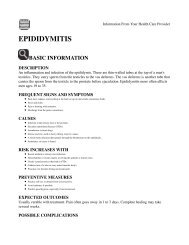HEMORRHOIDS
HEMORRHOIDS
HEMORRHOIDS
You also want an ePaper? Increase the reach of your titles
YUMPU automatically turns print PDFs into web optimized ePapers that Google loves.
Information From Your Health Care Provider<br />
<strong>HEMORRHOIDS</strong><br />
(Piles)<br />
BASIC INFORMATION<br />
DESCRIPTION<br />
Swollen veins of the rectum or anus. Hemorrhoids may be located inside of the anal canal, or at the<br />
anal opening. Hemorrhoids may be present for years, but go unnoticed until bleeding occurs.<br />
FREQUENT SIGNS AND SYMPTOMS<br />
Rectal bleeding. Bright-red blood may show as streaks on toilet paper or be a part of a bowel movement. Blood may be a slow trickle for a short while<br />
following bowel movements. It almost always colors the toilet water.<br />
Pain, itching, or discharge after bowel movements.<br />
A lump or swelling that can be felt in the anus.<br />
A feeling that the rectum has not emptied completely after a bowel movement.<br />
CAUSES<br />
Repeated pressure on the anal or rectal veins, which causes them to stretch.<br />
RISK INCREASES WITH<br />
A diet that lacks fiber.<br />
Prolonged sitting or standing.<br />
Overweight people.<br />
Pregnancy.<br />
Chronic constipation or diarrhea.<br />
Loss of muscle tone in older adults.<br />
Rectal surgery or episiotomy.<br />
Liver disease.<br />
Anal sex.<br />
Colon cancer.<br />
PREVENTIVE MEASURES<br />
Don't try to hurry bowel movements, but do try to avoid straining and prolonged sitting on the toilet.<br />
Lose weight if you are overweight.<br />
Include plenty of fiber in your diet.<br />
Drink 8 to 10 glasses of water per day.<br />
Exercise regularly.<br />
EXPECTED OUTCOMES<br />
Hemorrhoids usually clear up with proper care, but symptoms may come and go. Stubborn cases may<br />
require surgery.
POSSIBLE COMPLICATIONS<br />
Anemia, if there is a lot of blood loss.<br />
Severe pain caused by a blood clot in a hemorrhoid.<br />
Infection or inflammation of a hemorrhoid.<br />
DIAGNOSIS & TREATMENT<br />
GENERAL MEASURES<br />
Your health care provider can diagnose hemorrhoids by a physical examination of the rectal area. Medical tests may be done to check for complications.<br />
Treatment is aimed at easing the symptoms.<br />
Never strain to push your stool out.<br />
When sitting on the toilet, place feet on a low footstool to aid bowel movement.<br />
Clean the anal area gently with soft, moist paper after each bowel movement.<br />
To relieve pain, sit in 8 to 10 inches of warm water for 10 to 20 minutes several times a day.<br />
To reduce pain and swelling of a blood clot or swollen hemorrhoid, stay in bed for 1 day and apply ice packs to the anal area.<br />
Surgery may be recommended when simple treatment measures are not helping the symptoms.<br />
MEDICATIONS<br />
For minor pain, itching, or to reduce swelling, you may use drug products to relieve symptoms of hemorrhoids. If these symptoms occur during<br />
pregnancy, ask your obstetric provider which drugs are safe to use.<br />
Use a stool softener, if a laxative is needed.<br />
Other drugs may be prescribed for complications.<br />
ACTIVITY<br />
Get 30 minutes of exercise on a daily basis. Bowel function improves with good physical fitness.<br />
DIET<br />
To prevent constipation, eat a well-balanced diet that contains many high-fiber foods.<br />
Drink 8 to 10 glasses of fluid daily.<br />
Go on a weight-loss diet if you are overweight.<br />
NOTIFY OUR OFFICE IF<br />
You or a family member has symptoms of hemorrhoids<br />
Hemorrhoids continue to cause severe pain.<br />
A hard lump develops where a hemorrhoid has been.<br />
Rectal bleeding is heavy. Rectal bleeding can be an early sign of cancer.















